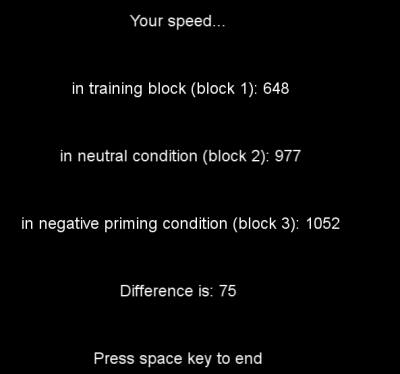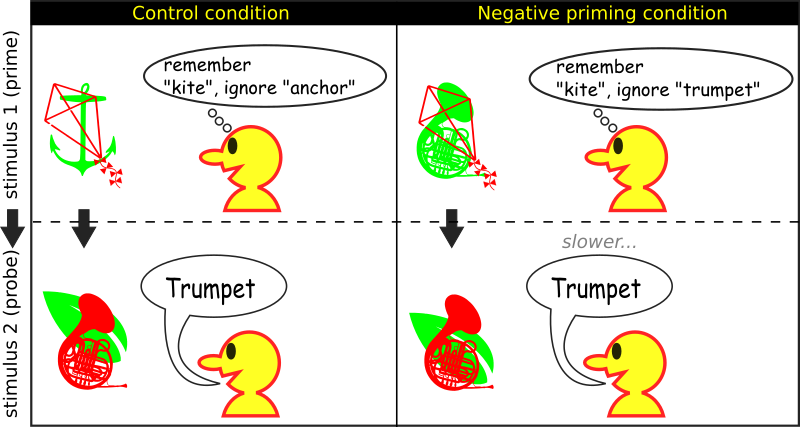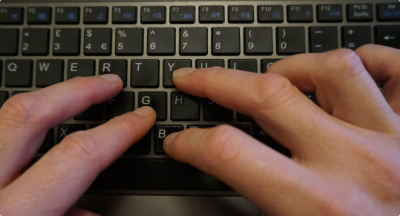Introduction
Negative priming is a slow down in response speed and an increase in error rate when responding to an object that had to be ignored previously (Tipper, 1985). In a review paper by Mayr & Buchner, (2007), it is argued that this phenomenon is not just related to the topic "attention", but also to "memory".
| The negative priming webpage on ScholarPedia is curated by Professor Tipper, who named the phenomenon in his 1985 paper. |
Probably the first ever negative priming study was by Dalrymple-Alford and colleagues (1966), although they did not call it "negative priming" back then. It was Steven Tipper (1985) who gave the phenomenon its name. In his study (Tipper, 1985, Experiment 1), participants were found to name objects more slowly when they had to ignore the same objects just before.
There are now hundreds of papers on negative priming, including a new review by Frings and colleagues (2015).
Negative Priming is today explained as resulting from at least two different types of cognitive processes:
-
Inhibition — According to this account, the cognitive representation of the to be named object (e.g., "trumpet") is still inhibited, because of the previous need to ignore this object.
-
Memory retrieval — According to this account, the ignored representation itself is associated with a memory of how to act upon it. This memory of not acting on (e.g., the trumpet) is still active and has an effect on subsequent action planning.
There are, however, more explanations (Frings, 2015), although one can argue that those are more refined elaborations of the two mentioned above. If you are interested in this, I strongly recommend to read the Frings review, which is a very accessible review for undergraduate psychology students.
About this implementation
This demo uses the design of the Dalrymple-Alford & Budayr (1966) paper. That paper does not use the name negative priming, but it is essentially the same effect (you may be able to download the original and very short paper from your library, it is worth checking). Note that it uses Stroop stimuli.
Do it yourself
| In this example, you will see color words similar to the Stroop task. There are three blocks. In the first block, you are simply trained in learning which button to press and how to do it without having to look at the keyboard. To train you on this, there are 20 trials. The following two blocks test the neutral and the negative priming conditions. |
What do the numbers mean?
If you have done the demo, you noted you got 4 numbers (see example screenshot below):

-
Your speed in milliseconds in the first block (in the example screenshot 648 ms). In this block, you just learned to respond to the colors. It takes some time to get used to knowing where the keys are without looking at the keyboard.
-
Your speed in milliseconds in the second block. In this block, you do the neutral condition. In this condition, there is no negative priming between the current word and the previous word
-
Your speed in milliseconds in the third block. In this block, you do the negative priming condition. In this condition, you respond to the color which you had to ignore in the preceding trial!
-
The difference between block 3 and block 2. This is the effect cognitive psychologists are interested in. Under normal conditions, the number should be greater than zero, that is, you would be slower in the third block than in the second block. In the example, the test person was 75 ms slower in the negative priming condition. This means, the negative priming made the person perform slower compared to the neutral condition.
Further reading
-
Dalrymple-Alford, E.C. & Budayr, B. (1966). Examination of some aspects of the Stroop color word test. Perceptual & Motor Skills, 23, 1211-1214.
-
Frings, C., Schneider, K.K., and Fox, E. (2015). The negative priming paradigm: An update and implications for selective attention. Psychonomic Bulletin & Review, 22(6), 1577-1597.
-
Mayr, S. & Buchner, A. (2007). Negative Priming as a Memory Phenomenon. Journal of Psychology, 215(1), 35-51.
-
Tipper, S.P. (1985). The negative priming effect: Inhibitory priming by ignored objects. Quarterly Journal of Experimental Psychology: Human Experimental Psychology, 37A, 571-590.


